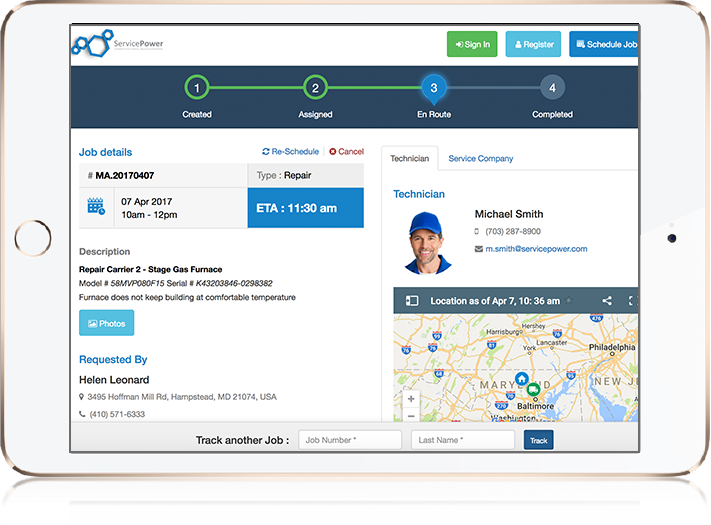ServicePower Recognized by Gartner in 2016
ServicePower Named a Visionary by Gartner in 2016 Magic Quadrant for Field Service Management ServicePower Technologies Plc (AIM: SVR), a market...

The International Data Corporation (IDC) predicts that the US mobile worker population will grow to 93.5 million in 2024, representing nearly 60% of the workforce. As more employees work remotely or outside the office, keeping everyone productive and connected is crucial, regardless of location.
Leveraging insights and analytics from integration solutions gives you the valuable data you need about your workers’ locations and tasks, allowing you to enhance processes and maximize efficiency.
Read on to discover how mobile workforce solutions can ensure your team’s success by delivering a connected and empowered workforce.
A mobile workforce is a group of employees performing their duties outside a traditional office setting, relying on mobile technology to stay connected and accomplish tasks. Common roles within a mobile workforce include field service technicians, sales representatives, and healthcare workers. Key technologies that enable mobile work include smartphones, tablets, and cloud-based software.
Although mobile and remote workers operate outside a traditional office setting, they differ in how and where they perform their tasks. Understanding these distinctions can help your business better support each group. Let’s take a closer look:
Mobile workforce solutions are rapidly evolving, making it essential to stay informed about emerging mobile workforce trends that can optimize employees' and customer experiences. Key innovations to consider include:
The global rollout of 5G networks offers faster speeds and stronger connectivity. For mobile workers, 5G enables smoother communication and seamless data transfer from any location. Field technicians can diagnose issues remotely via live video, and healthcare professionals can conduct virtual patient check-ups without in-person visits. The advent of 5G is transforming many industries by removing time and distance barriers for distributed workforces.
Companies are increasingly adopting augmented and virtual reality to improve training and job performance for mobile employees. Utility crews use AR to overlay detailed schematics on equipment or job sites, while VR allows retailers to preview store remodels before construction. Technicians can also practice complex tasks in a virtual environment, sharpening their skills prior to operating real-world equipment.
Innovative businesses use artificial intelligence mobile workforce solutions for mobile teams' scheduling, routing, and resource allocation. AI analyzes historical data on service needs and patterns, enabling more efficient planning of nurse home visits and predictive maintenance dispatches. This strategic allocation of mobile resources based on past trends enhances productivity and customer service.
Mobile workers now access real-time insights from sensors and wearable technologies. Smart garments monitor the vital signs of technicians in hazardous conditions, ensuring safety. Sensor-enabled tools provide remote access to machinery data, expediting troubleshooting. These Internet of Things solutions enhance decision-making and productivity for employees working in diverse mobile location services.
Distributed teams require reliable connectivity regardless of their location. Cloud-based platforms act as powerful collaboration hubs, enabling video conferencing, large file sharing, and joint project management from any device, ensuring continuous productivity for mobile teams.
As mobile devices become the primary tools for field-based work, businesses are now designing digital workflows with mobile accessibility and convenience as top priorities. This approach ensures that essential systems, tools, and resources are readily available on smartphones and tablets, maximizing flexibility and employee engagement.
Forward-thinking companies are integrating independent contractors and freelance workers into their mobile workforce, particularly during peak periods. This strategy brings in specialized expertise while maintaining the flexibility to adjust to fluctuating customer demand throughout the year.
Advancements in mobile technologies are transforming the field service industry, offering businesses revolutionary opportunities. By adopting mobile workforce solutions, you gain significant advantages, from increased efficiency to improved customer satisfaction. Here are the top six benefits that make these solutions indispensable in field service management:
1. Boosts Operational Efficiency: AI-powered mobile apps provide technicians with optimized workflows and essential tools, reducing overhead costs and improving workforce routing.
2. Enhances Customer Satisfaction: Mobile access to systems enables a more rapid reply to service calls and issues. Clients value the improved communication and convenience of digital services that accommodate their schedules.
3. Attracts Top Talent: Skilled professionals seek flexible, technology-driven work environments. Implementing mobile-first solutions shows a commitment to empowering employees, regardless of location.
4. Provides a Competitive Advantage: Investing in innovative mobile solutions allows companies to deliver superior service and faster response times. Customers favor businesses that leverage cutting-edge technologies.
5. Improves Data-Driven Decision-Making: Mobile workforce analytics offer valuable insights that help companies refine processes, maximize productivity, and strategically scale operations.
6. Increases Scalability and Adaptability: Agile mobile workforce management tools enable businesses to respond swiftly to changes in market demand. These flexible platforms support growth without limitations.
Facing inefficiencies in travel costs and customer satisfaction, Baxi turned to ServicePower's advanced scheduling solution. By optimizing routes and managing resources more effectively, Baxi achieved a 15% reduction in travel costs and a 10% increase in customer satisfaction.
Mobile workforce solutions, including AI-driven automation, workforce management, and IoT integration, are reshaping the field service industry. These innovations optimize efficiency, lower costs, and maximize customer satisfaction.
ServicePower’s field service management solutions are at the forefront of these changes, offering advanced tools that support blended workforces, combining human and AI capabilities. Recognized as a Visionary in the Gartner Magic Quadrant for Field Service Management, ServicePower is the ideal partner for harnessing mobile workforce innovations.
Key features of the solution include:
Discover how ServicePower can transform your business by booking a demo today.
.jpg)
ServicePower Named a Visionary by Gartner in 2016 Magic Quadrant for Field Service Management ServicePower Technologies Plc (AIM: SVR), a market...

On-demand vehicle service provider, Kambio, contracts to use and resell NEXUS FSTM ServicePower Technologies Plc (AIM: SVR), a market leader in ...

When your business model, backed by your current stack of enterprise workforce management software, has been working well, it's hard to see a reason...